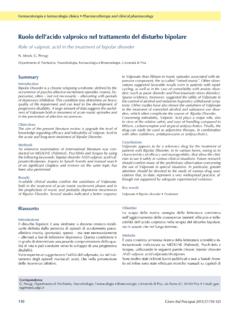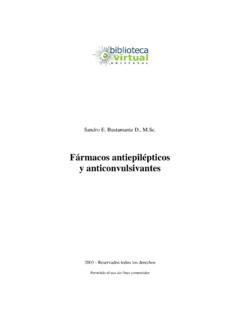Transcription of revisão Valproic Acid: Review - Revista Neurociências
1 Revis o Valproic acid : Review cido Valpr ico: revis o Sayonara Beatriz Ranciaro Fagundes1. SUMMARY RESUMO. Clinical pharmacologists, neurologists, and all health care giv- Farmacologistas, neurologistas e todos os cl nicos devem consi- ers must consider the efficacy, safety, and side effect profile of derar a efic cia, seguran a e efeitos colaterais das drogas anti- a given antiepileptic drug when determining which drug is best epil pticas quando determina qual melhor droga a ser dada ao for a given purpose of this study was to investigate paciente. A proposta deste trabalho investigar o cido valpr i- Valproic acid with a detailed analysis of the different reports. co com an lise detalhada de diferentes artigos. Keywords. Anticonvulsants, Enzyme Inhibitors, GABA Unitermos. Anticonvulsivos, Inibidores Enzim ticos, Agents. Agentes GABA rgicos. Citation. Fagundes SBR. Valproic acid : Review . Cita o. Fagundes SBR. cido Valpr ico: revis o.
2 Trabalho realizado no Neuroinstituto Forel, Itapema, SC. Endere o para correspond ncia: 1. M dica associada e pesquisadora do Neuroinstituto Forel e Especia- Sayonara Beatriz Ranciaro Fagundes lizanda UNIFESP. Rua 406A 75. 8822-000, Itapema, SC. Fone/fax: 47 33688775. E-mail: Recebido em: 10/05/05. Revisado em: 11/05/05 a 30/06/07. Aceito em: 02/07/07. Conflito de interesses: n o 130 Rev Neurocienc 2008;16/2:130-136. revis o BACKGROUND the expression of neuroprotective genes and protect The Valproic acid (VA) is an endogenous fatty against excitotoxicity. It is available in different dosa- acid , and was synthesized by Burton (1882)1 as an ge forms for parenteral and oral use. Sustained-rele- organic solvent. In 1963, Meunier et al, explored ase formulations are available that minimize fluctu- antiepileptic properties of new molecules and was ations in serum drug concentrations during a dosing surprised with this solvent's (VA) ability to protect interval and can therefore be given once or twice experimental animals against seizures2.
3 Its antiepi- daily. It is about 90% bound to plasma proteins, and leptic properties were recognized and in 1964, when the degree of binding decreases with increasing drug Carraz et al3 published the first clinical study which, concentration within the clinically occurring range. moreover, was used in all of Europe. Its introduction It is extensively me tabolized by microsomal glucuro- for clinical use in the USA occurred in 1978, initially nide conjugation, mitochondrial beta-oxidation and only to absence epilepsy and lately, in 1996, in par- cytochrome P450-dependent omega, (omega 1) and tial seizures. In the beginning it was formulated in (omega 2) oxidation8. acid form, later as a salt (sodium or magnesium) and VA, itself, is devoid of enzyme-inducing pro- as an amid. After absorption, all of these different perties, but it has the potential of inhibiting drug molecular structures are transformed into the val- metabolism and can increase plasma concentrations proate ion4.
4 Of certain coadministered drugs by this mechanism, The difference in this formulation of VA is its including phenobarbital (phenobarbitona), lamotri- solubility in water. VA is not sensitive to humidity, gine and zidovudine8-10. but sodium valproate is very hygroscopic and in the It is rapidly absorbed in the gastrointestinal gastrointestinal tract is impossible for it to disintegra- tract with a peak 1-4h after tablet ingestion,15- te in equal form, without constant fluctuations. For 60min after oral solution and after enteric this reason, laboratories developed the sodium dival- tablets retard4. proate molecule (Figure 1, Tables 1 and 2)4-6. Elimination of the drug appears to follow a monophasic exponential course: biological half-life Pharmacokinetic were 8 to15 hours, but shorter values (5 to 12 hours). In view of the diverse molecular and cellular are observed in patients medicated with enzyme-in- events that underlie different seizure types, the com- ducing agents.
5 The drug appears to have a relatively bination of several neurochemical and neurophysio- restricted distribution: calculated relative distribu- logical mechanisms in a single drug molecule might tion volumes ranged from to There explain the broad antiepileptic and other brain disea- were large individual differences in clearance rates. se efficacy of VA7. Furthermore, by acting on diverse The therapeutic range was considered to be betwe- regional targets thought to be involved in the genera- en 50 and 100 mg/l plasma. Determination of the tion and propagation of seizures, VA may antagonize plasma concentrations of drugs at accurately fixed epileptic activity in several steps of its organization7. times appears to be a reliable method for the phar- Its pharmacological effects involve increased macotherapeutic monitoring of epileptic patients. gamma-aminobutyric acid (GABA)-ergic transmis- The High Performance Liquid Chromatographic sion, reduced release and/or effects of excitatory (HPLC) method was used, which determines dia- amino acids, blockade of voltage gated sodium zepam as an internal standard (IS).
6 The method is channels and modulation of dopaminergic and se- simple, rapid, accurate, and sensitive8,11,12. rotoninergic transmission. These drug may regulate Use VA is a broad spectrum anti epilieptical drug (AED) being effective against all seizure types. In pa- tients with newly diagnosed partial seizures (with or without secondary generalization) and/or primarily generalized tonic-clonic seizures, the efficacy of val- proate is comparable to that of phenytoin, carba- mazepine and phenobarbital. Valproate is generally regarded as a first-choice agent for most forms of Figure 1. Valproic acid molecular structure66. symptomatic and idiopathic generalized epilepsies8,13. Rev Neurocienc 2008;16/2: 130-136 131. revis o Idiopathic generalized epilepsy (IGE), sometimes in metastasis, but also induces tumor differentiation in association with Lamotrigine14. vitro and in increases the DNA binding of Generalized epilepsies seem to be particularly activating protein-1 (AP-1) transcription factor, and vulnerable to seizure aggravation, and medications the expression of genes regulated by the extracellu- that are primarily effective against partial seizures lar regulated kinase (ERK) AP-1 pathway; VA do- are more commonly involved in seizure aggravation wnregulates protein kinase C (PKC)activity; inhibits than other medications15.
7 Broad-spectrum AEDs glycogen synthase kinase 3 beta (GSK-3 beta); VA. such as Valproate, Lamotrigine and Topiramate are activates the peroxisome proliferator-activated re- extremely effective at controlling a variety of seizu- ceptors (PPAR) gamma and delta; VA blocks HDAC. res without causing excessive seizure aggravation14,15. (histone deacetylase) causing Sodium Valproate 400 mg-1800 mg daily is an useful might also be useful as low toxicity agent given over addition to anti-convulsant therapy with beneficial long time periods for chemoprevention and/or for effects in the majority of patients with grand mal, control of residual minimal disease22-26. petit mal; myoclonus, and akinetic attacks. Temporal Mood-stabilizing properties. It has been reported lobe epilepsy and other focal cortical seizures res- to preferentially increase dopamine (DA) release in rat ponded less well. The transition period, while other medial prefrontal cortex (MPFC), an effect partially or anticonvulsants were being withdrawn, was 7 10 fully inhibited by WAY 100635, a selective 5-HT (1 A).
8 Days, when it becomes fully active,other anticonvul- antagonist. Ichikawa et al9, suggest that the result indi- sants should be withdrawn only after the patient is cate that not all mood-stabilizing agents, but only those established on a maintenance dosage15,16. which have anticonvulsant mood-stabilizing properties, Lennox Gastaut Syndrome (LGS), which appears increase DA release in the cortex and that the effect in children aged between 2 and 8 years old, is charac- is dependent upon 5-HT(1A) receptor stimulation. terized by a triad of epileptic seizures with different Cheng et al27 report that VA directly inhibits recombi- patterns, variable degrees of mental retardation, an nant prolyl oligopeptidase (PO) activity, which would electroencephalogram (EEG) with slow spike wave have the opposite effect on phosphoinositide (PIns) sig- complex at Hz and bursts of rapid centrotem- naling inhibition of PO activity is reported to enhance poral activity, with a variable response in the control PIns signaling consistent with the suggestion that mood of the epileptic seizures17.
9 Stabilizers inhibit Pins unexpected result Landau-Kleffner Syndrome is a rare, functional, suggests a model that could explain the dual action of age-related epilepsy with aphasia and epileptiform VA in mood stabilizing: euthymic mood is dependent discharges on aphasia responds poorly to on stable PIns signaling and VA may limit mood swings most drugs. Valproic acid and benzodiazepines are to mania by decreasing PIns signaling, additionally, it most effective18. may limit mood swings to depression by inhibiting PO. West Syndrome, some reports have indicated the and thus increasing PIns signaling9,25,27. possible efficacy of VA in regular large (40-100 mg/Kg/ Alzheimer. For symptomatic treatment of agita- day) and very high (100 300 mg/Kg/day) doses19. tion in Alzheimer's disease28. Neuropathy. In the management of painful dia- Migraine. Intravenous Valproic acid is one option for betic neuropathy20. emergency treatment of migraine and prophylaxis29,30.
10 Peripheral nerve injury. The potential clinical ap- Panic attacks. In patients with panic attacks not plication for the treatment of peripheral nerve injury responding to antidepressants31. in humans21. Toxoplasma. It inhibited the Toxoplasma gondii at Anti-cancer. It is associated with anti-cancer a concentration below that found in the cerebrospi- activity. VA not only suppresses tumor growth and nal fluid and blood of individuals being treated with this medication and displayed synergistic activity Table 1. General characteristics of formulations of VA5. with haloperidol and with trimethoprim, an antibio- Sodium tic commonly used to treat toxoplasma infections32. Valproic acid Sodium Valproate Divalproate Dyskinesia. It has potential as an effective pharma- Natural form liquid Power power cological tool in the treatment of tardive dyskinesia33. Molecular weight Idiopathic olfactory hallucination. The symptoms not hygros- of some cases of Idiopathic olfactory hallucination Solubility high Hygroscopic copic may be controlled by sodium valproate34.











